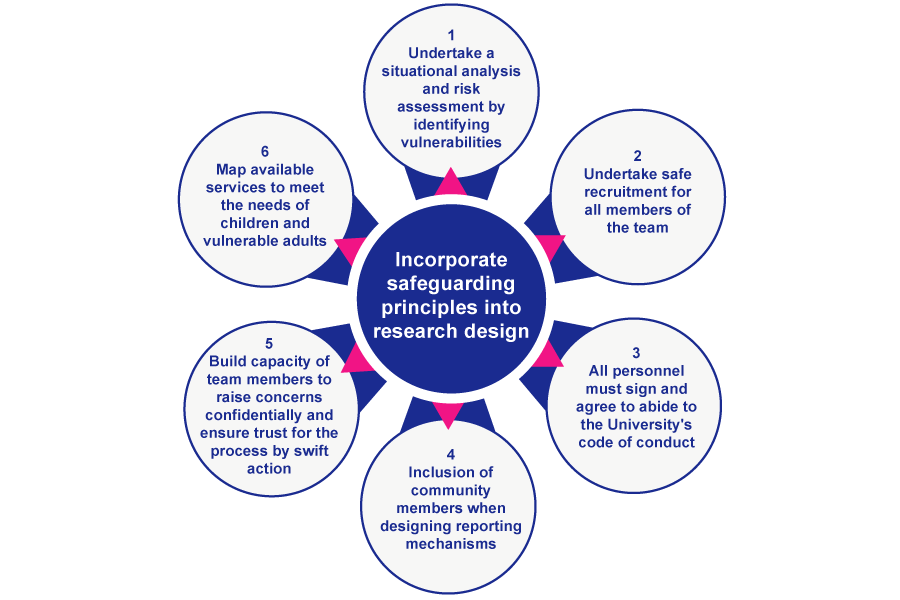Unit 2: Identification
2.3 Safeguarding in research
Organisations working in the international aid sector often undertake research. This section covers how principles governing research and data collection can be applied with a focus on safeguarding.

When we undertake activities and programmes with communities, we should be aware of their vulnerabilities (and the intersectionality of factors) and ensure that we do not increase the risk of harm.
For example, if you work in data collection, monitoring or research it’s important to identify community vulnerabilities so that appropriate safeguarding measures can be put in place prior to and during any activity.
|
Activity 2.5 Case Study Let’s apply what we have learnt so far on vulnerability and risk of harm using the case study below:
Note some ideas in your learning journal. ABC University has obtained donor funding to undertake research in a rural, farming community in District D. The objective of the research is to gauge how the recent drought in the area has affected the lives of women and children of this community made up of a minority ethnic group with a low literacy rate. Since the drought, the farmers have lost their livestock and income. There has been a spike in domestic violence in family homes. Teachers have not been paid for several months and have stopped working. Traffickers have started roaming the area, enticing parents to give them their children for a “better life”. Instead, children are being trafficked to neighbouring countries to be married or to beg on the streets to support family incomes. There is anecdotal information that some of the boys have lost limbs due to accidents when illegally working on farms. The research team will be made up of local data collectors. The results of the research will help address some of these problems in this community. |
Research ethics and safeguarding
When undertaking research, academic institutions, consulting firms and data collectors may typically use ethical research principles to guide them.
These ethical principles may include:
- Research which should aim to maximise the benefits for individuals and society and minimise risk and harm.
- A clause or standard to ensure that the rights and dignity of individuals and groups are always respected.
- Wherever possible, that participation should be voluntary and appropriately informed (i.e. informed consent and in accordance with data protection laws).
- A clause or standard to ensure that research is conducted with integrity and transparency at all times.
- Lines of responsibility and accountability which should be clearly defined.
- Independence of research which should be maintained and, where conflicts of interest cannot be avoided, such conflicts should be made explicit.
(Source: Our core principles - Economic and Social Research Council (ukri.org))
These important ethical principles could be expanded further using a safeguarding lens.
For example, we should incorporate safeguarding principles into the project design from the outset by identifying the vulnerability of research participants, the potential of increasing risk of harm to them when undertaking research, and the obvious power differential that exists between a researcher and research participant.
If you want to find out more about safeguarding in research, follow the links below:
- Safeguarding in International Development Research: A Briefing Paper (PDF) University of Sussex
- How can we ethically involve children in research? ECPAT
- Research Integrity UKRI
Incorporating safeguarding principles in the research

The team at the University in the case study should incorporate safeguarding principles into their research design right from the beginning, since any form of data collection for the purpose of research is not without risk. This is because asking research questions may lead to the re-traumatisation of the interviewees and / or make him/her/them more fragile and vulnerable. Some research programmes offer incentives for participation, and this can be manipulated to the disadvantage of the interviewee. It is important to identify safeguarding risks in undertaking research because of the potential contact with vulnerable populations and the likelihood of abuse given the asymmetric relations between the researcher and the population to be researched.
Researchers should make ethical decisions by identifying vulnerabilities of and risks to research participants and put in place reasonable steps to minimise and mitigate these, ensuring that the best interests of the research participant are central.
Using the project cycle management model of Identify, Design, Implement, Monitor and Learn, the diagram above illustrates some of the steps to take by those who conduct data collection for research in order to mitigate and minimise risks using a safeguarding lens.
